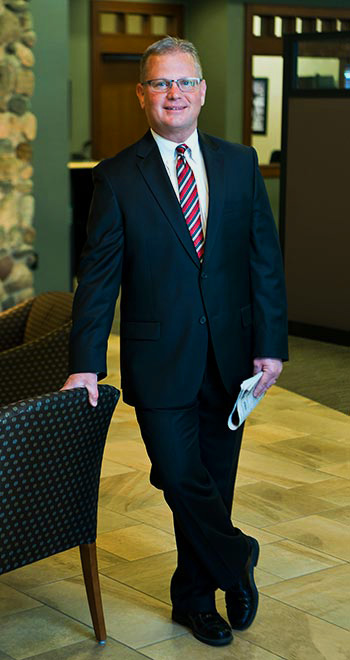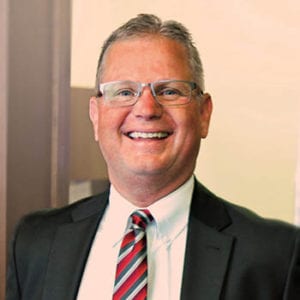Banking on a strong client relationship

Bell Bank/Bell Investments • Cetera Investment Services
Read full biography below
 There are three main differences to working within a bank environment versus working independently, all of which I believe work to the benefit of my clients. First, many of my clients have an existing financial relationship with Bell Bank. New clients either come in through a current client referral or directly through a banking relationship. There is a certain comfort level for people in knowing that they are working with a representative of a highly respected financial institution.
There are three main differences to working within a bank environment versus working independently, all of which I believe work to the benefit of my clients. First, many of my clients have an existing financial relationship with Bell Bank. New clients either come in through a current client referral or directly through a banking relationship. There is a certain comfort level for people in knowing that they are working with a representative of a highly respected financial institution.
Second, since I am taking a holistic look at an individual’s or family’s overall financial-planning needs, it is beneficial to have access to many different professional resources. These include all of the appropriate departments of the bank, such as our asset management team, a specific financial-planning group, 401(k) experts, our trust department, and so forth. I also receive excellent support from our broker-dealer, Cetera Investment Services.
Lastly, there is a distinction regarding my compensation. I am transparent with clients in explaining that I am a salaried employee of the bank. My compensation is not impacted by any of the products, services, or investments that I recommend. I want to reassure clients that they are receiving unbiased guidance. A client really should not have to worry about that with any advisor. Full disclosure is very important. I want to make sure people know exactly what they are paying, what it is for, and how it is being charged. But what is equally important is communicating that our objectives are aligned with the client’s—that we are working on the same side of the table.

The personal touch is very important, so we conduct periodic bank staff meetings where our advisor group will present information on our capabilities and any new developments in our area. We have also started quarterly “lunch-and-learn” sessions with all of the branch employees. These are part education on financial-planning issues or current market developments and part review of how we can potentially serve the bank’s customers. These activities help keep the advisor group top of mind with bank employees and make them aware that they should be looking for appropriate opportunities to refer our services to bank customers.
Our financial planning revolves around a basic five-step framework:
- The discovery stage, which includes understanding what a client feels is important in their lives and their financial situation and explaining how we work as advisors.
- Learning the detailed facts about a client’s overall financial situation and assets. This also covers a more data-driven, comprehensive review of a current portfolio; establishing investment objectives; and determining a risk profile.
- Developing recommendations based on the financial profile, risk tolerance, and overall objectives.
- Finalizing a plan that best meets the established financial goals.
- Developing an ongoing partnership, which includes review sessions and regular communication. In many cases, it will also be appropriate to work with a client’s attorney, accountant, and other advisors.

With the bucket planning approach, we can use many different types of investments, depending on the bucket and the income need. We want to produce growth in later buckets to replenish the first bucket that is funding immediate income needs. The overall investment plan could be a blend of dividend-paying mutual funds, various types of annuities, tactically managed equity or fixed-income funds, and alternative assets such as REITs or BDC closed-end funds. It is a challenging environment right now with very low interest rates, but we are able to construct risk-managed solutions for our clients that can address their needs.
A big part of my role is education, whether it is explaining the concept of the sequence of returns or showing clients how various asset classes and sectors have performed very differently throughout the history of the market. When you consider those two factors together, why would anyone want to have their lifetime assets tied to a benchmark that has shown the potential to lose over 50% during a drawdown period?
The investment managers I select have the experience and models to construct active and tactical portfolio strategies that will help mitigate risk. These may not always be the best-performing strategies in all market environments, but they do very well against the objective of minimizing portfolio volatility, achieving competitive returns, and creating a smoother ride for clients. I believe that this approach provides a very valuable benefit for our clients, especially those facing their retirement years.
 Brad Bakken is a vice president and financial advisor with Bell Investments, located at Bell Bank. Mr. Bakken has over 20 years of experience in the financial-services industry, with knowledge in insurance, retirement and financial planning, employee benefits, and investments.
Brad Bakken is a vice president and financial advisor with Bell Investments, located at Bell Bank. Mr. Bakken has over 20 years of experience in the financial-services industry, with knowledge in insurance, retirement and financial planning, employee benefits, and investments.
Mr. Bakken grew up in Rugby, North Dakota, a small town recognized as the “geographical center of North America.” He studied at North Dakota State University in Fargo and started his business career in the retail and food-services industries. He later transitioned to financial services and worked in positions of increasing responsibility with the nonprofit Lutheran Brotherhood (now Thrivent Financial) and BancWest Investment Services.
Mr. Bakken joined Bell Investments in 2012 and says, “I feel the culture and reputation of this company is the best in the industry. When everyone works together to exceed our customer’s expectations, everyone wins.” He provides a variety of planning and investment services for the clients of the bank and particularly enjoys working to address the multigenerational needs of families. A Certified Retirement Counselor (CRC), he works with pre-retirees on accumulation strategies and post-retirees on distribution planning.
Mr. Bakken and his wife have two adult children and seven grandchildren. He enjoys spending time with his extended family and friends, and—when time permits—he plays racquetball and golf. Mr. Bakken served as president of the local Chamber of Commerce, the Wahpeton school board, and the Kiwanis Club, and has taught courses at North Dakota State College of Science. He is also an active participant in his bank’s “Pay it Forward” charitable-giving program.
Disclosure: Financial advisors offering securities and insurance products through Cetera Investment Services LLC, member FINRA/SIPC. Advisory services are offered through Cetera Investment Advisers LLC. Neither firm is affiliated with the financial institution where investment services are offered. Advisory services may only be offered by investment adviser representatives in conjunction with an advisory services agreement and disclosure brochure as provided. Investments are not FDIC/NCUSIF insured, may lose value, are not financial institution guaranteed, are not a deposit, and are not insured by any federal government agency. Investors cannot invest directly in indexes. The performance of any index is not indicative of the performance of any investment and does not take into account the effects of inflation and the fees and expenses associated with investing. Bell Investments, 717 Second Ave. N., Wahpeton, ND 58075. 701-672-2265.
Post-publication note: Mr. Bakken has been registered with LPL Financial LLC since 2017.
Photography by Dan Koeck


